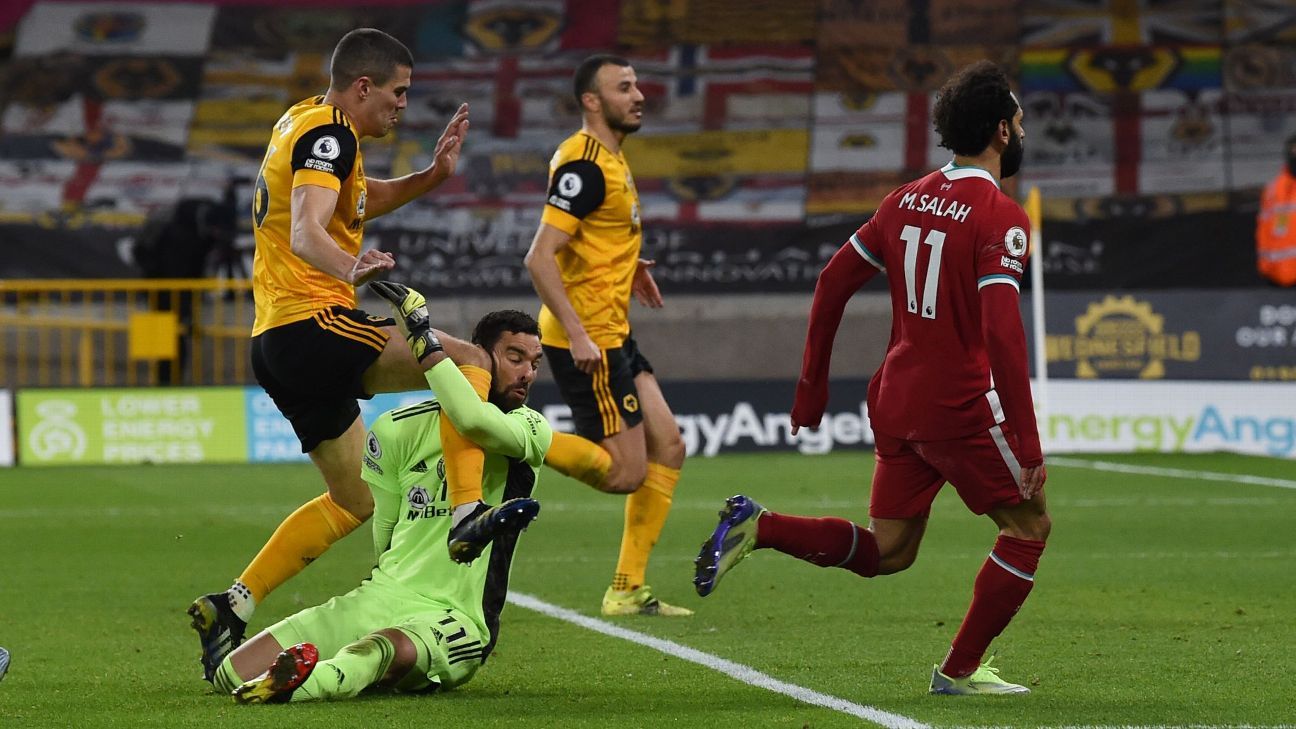Football has become a game that is now decided by the finest of margins since the introduction of VAR, so it is impossible to say whether Wolverhampton Wanderers goalkeeper Rui Patricio would have avoided injury during Monday’s 1-0 defeat against Liverpool had the offside rule not been changed to accommodate video technology.
But as football searches for certainty and perfection, with every frozen frame being studied for the slightest infringement or every offside decision measured by millimetres, there are potential risks and consequences and the one fear that has been voiced by many within the game — of an offside flag being kept down long enough for a player to be badly injured — came to fruition at Molineux.
Patricio, the Portugal No. 1, was treated on the pitch for almost 15 minutes, before being carried off on a stretcher, after colliding with defender Conor Coady in the 86th minute when both players were attempting to prevent Mohamed Salah scoring for Liverpool.
As it happened, Salah did score, but the assistant referee’s flag was subsequently raised to signal offside after the ball hit the back of the net.
By that stage, however, Patricio was lying motionless on the ground in the six-yard box after taking an accidental blow to head while colliding with Coady.
“It was an awful situation,” Liverpool manager Jurgen Klopp said. “It was a proper shock.”
Thankfully for Patricio, the 33-year-old regained consciousness shortly after leaving the pitch, with Wolves manager Nuno Espirito Santo saying, “He’s conscious, he remembers what happened, he’s aware.
“The law is clear,” Nuno added. “The referees keep the flag down and play to the whistle. Situations will happen. This won’t be the only time.”
Patricio’s injury led to back-up keeper John Ruddy being used as a concussion sub, which is one positive change to the rules of the game, but perhaps one that was only introduced mid-season in January because of a fractured skull suffered by Wolves forward Raul Jimenez against Arsenal in November.
But the incident involving Patricio and Coady will now raise further questions as to the wisdom of the offside protocol which requires assistant referees only to flag for offside at the end of the phase of play.
The theory is sound enough — if a flag is raised at the end of the move, it can be checked by VAR and any decision to which is proved to have wrongly ruled a goal offside can be overturned and the goal awarded.
If a flag goes up too early and a player is shown to have been onside, rather than offside, they miss the chance to take advantage by scoring a goal.
But while the rule change is rooted in a sense of fairness, the injury to Patricio highlights why so many within the game believe that the offside rule now poses a risk to players.
If a move is allowed to proceed after an offence is committed, a player may be injured while attempting to stop a goal or even score one.
Why put players at risk when the play is so obviously and clearly going to be brought back once the flag is raised?
The Patricio-Coady incident is perhaps not the best example of the dangers of play being allowed to run on in an offside move.
Less than two seconds elapsed between Salah receiving the ball and scoring, so the assistant and referee would have to work quickly to flag and whistle for the move to be stopped.
But even in that short space of time, a raised flag or referee’s whistle may have prompted Coady to halt his run back towards goal. Similarly, Patricio would not have followed through on his attempt to save Salah’s shot.
0:39
Liverpool’s 1-0 win at Wolves doesn’t change Steve Nicol’s mind about their chances of making the top four.
Fine margins again, but on viewing the replay of the move, there appears to be just enough time between the ball being played to Salah and the run into the penalty area for the officials to halt the play.
Based on Nuno’s positive update on Patricio’s condition, the keeper may have got off lightly, but the situation with late whistles or flags mean that something similar could happen again, but worse.
What if a player breaks a leg or damages knee ligaments making a last-ditch challenge to prevent a goal, which would have been ruled out for offside anyway?
Or maybe a player will pull a hamstring and face weeks on the sidelines by chasing a ball that didn’t need to be chased.
The injury to Patricio ultimately overshadowed a dour game which resulted in the narrow win that keeps Liverpool’s hopes alive of a top four finish.
Diogo Jota’s goal against his old club in first-half stoppage time was enough to claim all three points and move Liverpool into sixth position, five points behind fourth-placed Chelsea.
“It’s all about the result,” Klopp said. “A big fight. If we want three dirty points, I’m fine with that.”
This game won’t be remembered for the result, however. It was all about Patricio and the injury he sustained. Fortunately, it has proven not to be serious, but he won’t be able to thank the rules of the game for that.
